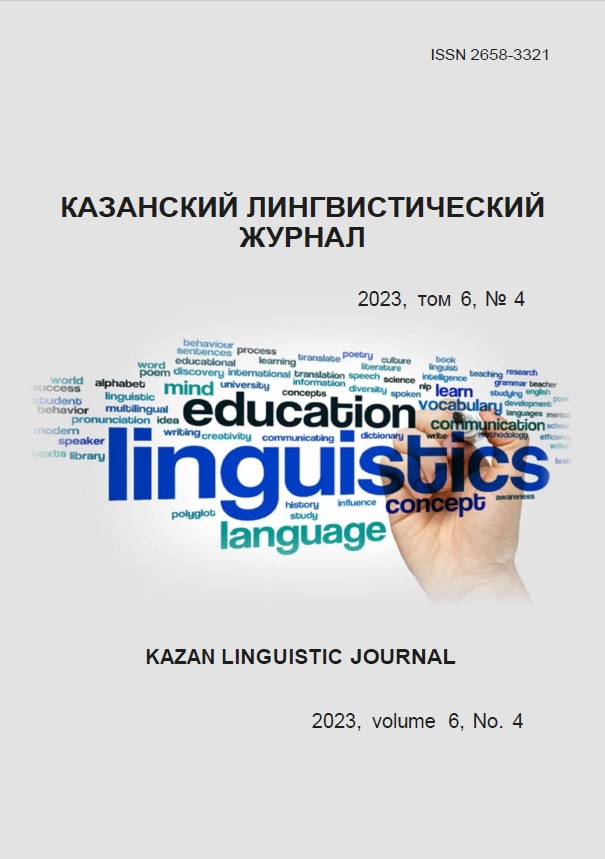Variability of Intonation in Russian and German (on the Example of Speeches by A. Gordon, D. Nagiyev, G. Jauch, S. Raab)
https://doi.org/10.26907/2658-3321.2023.6.3.512-523
Keywords:
intonation, pitch frequency, pause, speech tempo, Speech AnalyzerAbstract
The aim of this study was to examine intonation variability according to the country of origin of the native speaker. It also focuses on shedding light on the factors that contribute to the variation in intonation in these languages. The study was conducted using the Speech Analyzer program, which provides the ability to process sounding speech. The materials used in this study included video clips of speeches by public figures from Russia and Germany, namely A. Gordon, D. Nagiyev, G. Jauch and S. Raab. The materials were obtained from YouTube videos hosting. This study was conducted in two stages. The first stage is the perceptual-auditory analysis of sounding speech. In the second stage, an electron-acoustic (instrumental) study was conducted. Instrumental research with the help of the program involves the measurement of intonation indicators, such as the number, duration, and frequency of pauses; speech tempo; maximum and minimum indicators of pitch frequency. The results of the analysis show that both Russian and German exhibit considerable variability in the patterns of intonation, which may be influenced by a variety of factors such as the speaker's emotional state, communicative context, and linguistic structure of the speech. The indicators of pace of speech differed the most. Thus, the monotony of temporal organization is characteristic of a Russian-speaking TV presenter, while for German-speaking TV presenters, there is often acceleration preceding or following the focal element as well as acceleration of semantically insignificant elements. The nature of the pauses also was different. For speakers of different languages, pauses change in duration, frequency, and character. The pitch frequency indicators were similar. All the parameters mentioned above must be considered when studying intonation differences between speakers of other languages.
References
References
Akhmanova O.S. Dictionary of Linguistic Terms. Kaluga, GUP Oblizdat; 2004. vol. 2. 569 p. (In Russ.)
Elsukova L.A. Intonation as one of the factors of perception of sounding speech at the syntactic level. Vestnik VyatSU Publ. 2011. №1. Available from: https://cyberleninka.ru/article/n/intonatsiya-kak-odin-iz-faktorov-vospriyatiya-zvuchaschey-rechi-na-sintaksicheskom-urovne [accessed: 22.02.2023]. (In Russ.)
Turygina L.A. Modeling of language structures by means of computer technology. Moscow; 1988. 176 p. (In Russ.)
Panchenko Yu.V. Investigation of individual characteristics of voiced speech. Siner-giya Publ. 2017. vol.6. Available from: https://cyberleninka.ru/article/n/issledovanie-otdelnyh-harakteristik-ozvuchennoy-rechi [accessed: 12.02.2023]. (In Russ.)
Pospelova S.N. To the Problem of Perception and Description of Tembral Voice Characteristics in Children's Game Communication. Kazan Linguistic Journal. 2023;6(2):271–281. (In Russ.). https://doi.org/10.26907/2658-3321.2023.6.2.271-281
Potapova R.K., Lindner G. Features of German pronunciation. Moscow, Vyssh. shk. Publ. 1991:7–19. (In Russ.)
Punik I.A. Prosodic characteristics of a word and intonation of a sentence (based on the material of the German language). Ul'yanovskiy gosudarstvennyy universitet Publ. [Ulyanovsk State University Publ.]. Ulyanovsk; 2020. 212 p. ISBN 978-5-88866-826-9. EDN FVJZFG. (In Russ.)
Khromov S.S. Semiotic essence of intonation. VolSU Herald. Series 2: Linguistics. 2014. vol. 2. Available from: https://cyberleninka.ru/article/n/semioticheskaya-suschnost-intonatsii [accessed: 07.02.2023]. (In Russ.)
Linguistic encyclopedic dictionary. Editor-in-chief Yartseva V. N. edition 2., add. Moscow: Great Russian Encyclopedia. 2002:324–406. (In Russ.)
Speech Analyzer. Electronic resource. Available from https://phonologyassistant.sil.org/ [accessed 15.02.2023].






